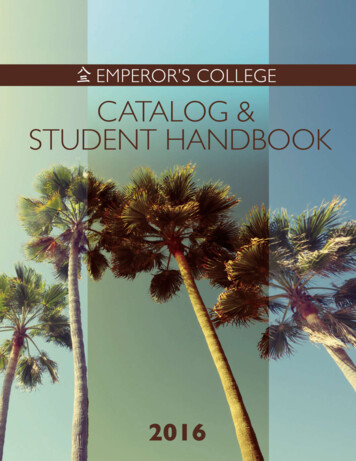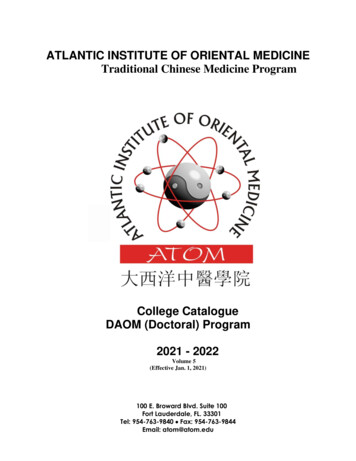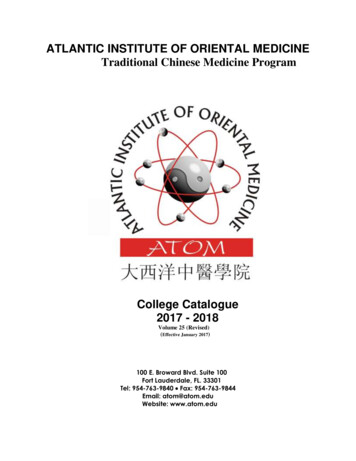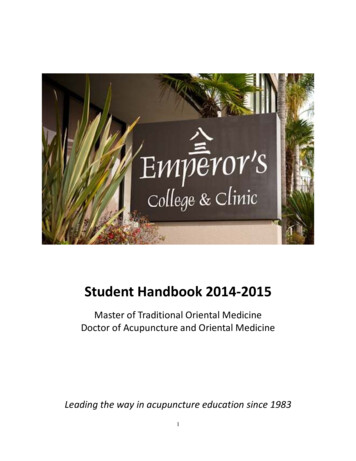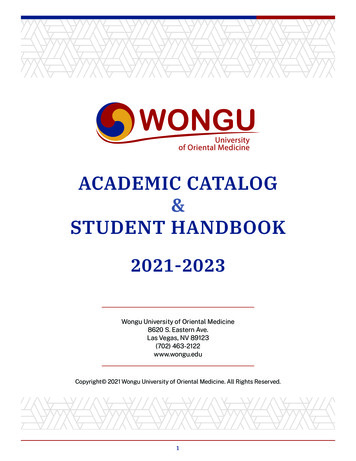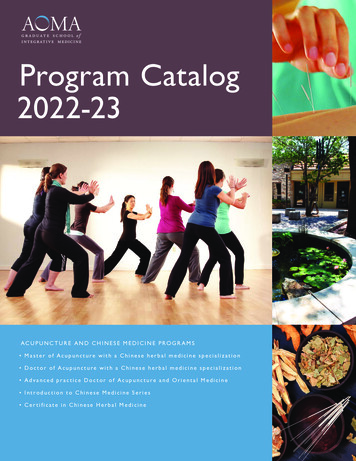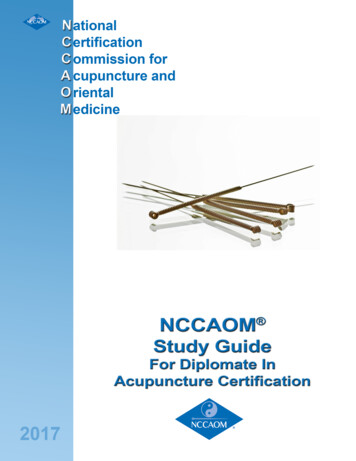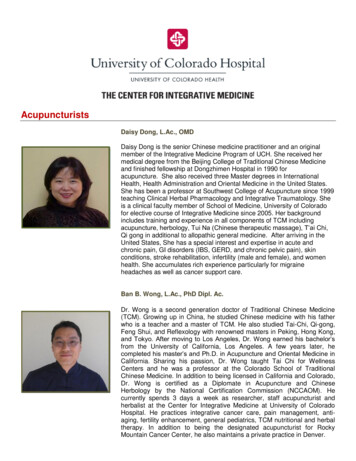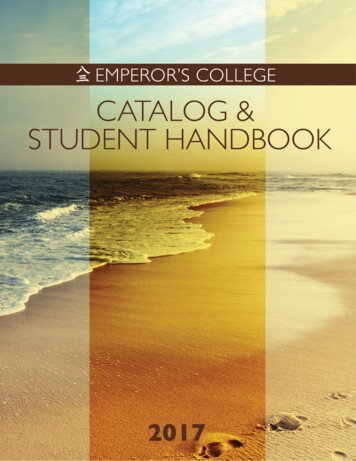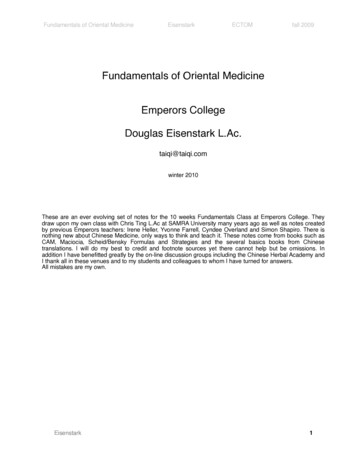
Transcription
Fundamentals of Oriental MedicineEisenstarkECTOM !fall 2009Fundamentals of Oriental MedicineEmperors CollegeDouglas Eisenstark L.Ac.taiqi@taiqi.comwinter 2010These are an ever evolving set of notes for the 10 weeks Fundamentals Class at Emperors College. Theydraw upon my own class with Chris Ting L.Ac at SAMRA University many years ago as well as notes createdby previous Emperors teachers: Irene Heller, Yvonne Farrell, Cyndee Overland and Simon Shapiro. There isnothing new about Chinese Medicine, only ways to think and teach it. These notes come from books such asCAM, Maciocia, Scheid/Bensky Formulas and Strategies and the several basics books from Chinesetranslations. I will do my best to credit and footnote sources yet there cannot help but be omissions. Inaddition I have benefitted greatly by the on-line discussion groups including the Chinese Herbal Academy andI thank all in these venues and to my students and colleagues to whom I have turned for answers.All mistakes are my own.Eisenstark1
Fundamentals of Oriental MedicineEisenstarkECTOM !fall 2009These are notes for the Fundamentals of Oriental Medicine class.They were compiled by Douglas Eisenstark L.Ac. All rights reserved. Please do not copywithout permission including and especially .Yin and YangThe Vital SubstancesShen, Qi, Xue, Jin/Ye, Jing3.5 Elements4.The distribution of QiZang Fu Organs introduction5.Zang Organs - Fu Organs6.Midterm7.Extraordinary Organs8.8 ParametersRoot and BranchPathology and EtiologyOutcomes to disease9.AcupunctureMeridiansExtraordinary Vessels10.InterrelationsEisenstark2
Fundamentals of Oriental Medicine EisenstarkECTOM !fall 2009Douglas Eisenstark L.AcEducation Tips: Your classmates, teachers and administrators are your future colleagues. Try not to talk in class. Donʼt talk about your own or family case in class. Donʼt worry about not knowing everything. Things will come back. Donʼt be afraid to ask questions. If you have questions, chances are some one elsedoes also. (And speak up so everyone can hear.) You will get angry. There are a lot of demands put on you.The years Year one - learning to learn Year two - the meat Year three - review and expansion Year four - focus on the clinic and boardsEisenstark3
Fundamentals of Oriental MedicineEisenstarkECTOM !fall 2009Chinese religious philosophy comes under Medicine. Philosophy generally comes under ethics and governance. Therefore there is a confluence of mystical - spiritual - religious practices within the medicine. Incorporates–Clinical Medicine (curing people)–Medical theory–Philosophy–Chinese Philosophy Both binary (2ʼs) AND tripartite (3ʼs) Yin Yang - twoʼsShen, Qi, Jing or heaven, human, earthThe Tai JI - undifferentiated wholeYin and Yang balance dynamically creating existence - process This interaction creates QI - process and potential within matter lifeConception (yang)Activity (Qi)Decay (yin)Clinical Medicine Acupuncture Herbs Tui-na (massage) Diet Qi Gong & Tai Ji Incantations and ceremony meditation形之上学 - Chinese medicine - study above the form形之下学 - Western medicine - study below the formAcupuncture&Eisenstark4
Fundamentals of Oriental MedicineEisenstarkECTOM !fall 2009MOXA针灸In the West acupuncture is: Needles Moxa Bleeding Gua sha Cupping HerbsIn China: Chinese MedicinePhilosophyReligionMeditationTai Qi/ Qi GongMassageHerbs “Internal Medicine”MoxaAcupuncture阴阳 Yellow Emperor said, “ Yin corresponds to stillness and its energy symbolizes the earth while Yangcorresponds to motion and its energy symbolizes the heaven, so, Yin and Yang are the ways ofheaven and earth. As the birth, growth, development, harvesting and storing of all things are all carriedout according to the rule of growth and decline of Yin and Yang, so, Yin and Yang are the guidingprinciples of all things. In the mutual victory or defeat of Yin and Yang, the situations will be ofnumerous varieties, so, Yin and Yang are the parents of variations. Yin grows while Yang is in vigorand Yin becomes deficient while Yang is weakened. From birth to death all things follow the principlesof Yin and Yang, so Yin and Yang are the basis of birth and death. When the Yin and Yang areharmonized, the spirit will emerge, so Yin and Yang are the mansions of spirit. 阴 阳 yángyīn - the moon太阳 tàiyáng the sun日 rì - dayEisenstark5
Fundamentals of Oriental MedicineEisenstarkECTOM !fall 2009History(Chinese Acupuncture and Moxibustion CAM - 1-11) Around 700 BC - First recordsShang dynasty - turtle shells - scabies, tinnitus, diarrhea, insomnia, diseases of head, eye, ear, nose andskin, gynecology, pediatric.Western Zhou, spring and autumnMountain and Sea classic - pathological wind, abdomen masses, epedemicMawangdui Tombs- 52 kinds of diseasesThe Neijing/ Yellow Emperorʼs Classic of Internal Medicine(200 B.C ?.)2 partsSu Wen - Plain QuestionsLing shu - Spiritual AxisSu Wen- set up as a conversation between the Yellow Emperor and Qi Bo much like Plato.Subjects includeTheory of diseaseAstrology5 elementsYin and YangPrinciples of TreatmentDiagnosisHealth lifestyleSigns and symptomsLing ShuAcupuncture and moxibustionZang FuTypes of needling and techniquesTypes of Qi160 acupuncture pointsShang Han Lun 200 BC - Treatise on Cold Diseases - began “modern” herbal practices, patterndiscrimination, systematic correspondence, 397 diagnostic and treatment principles,Synopsis of Prescriptions of the Golden chamber - 3 kinds of disease - 250 prescriptionsSystematic Classic on Acupuncture - Huangfu Mi - 250 ADPulse classic Wang Shuhe - 24 types of pulse condition General Treatise on the Causes and Symptoms of Diseases- Chao Yuanfang during Sui Dynasty - 600 AD700 AD - Acupuncture Colleges in JapanBronze Men - 1027 - Wang Weiji1949 - Chinese Revolution - modern “TCM”Eisenstark6
Fundamentals of Oriental MedicineEisenstarkECTOM !fall 2009Wen Bing - warm diseases - 1600ʼsTaosimChinese - 300 ADBased on Lao Tzu - nature and the individualCounters Confucianism - family traditionsBuddhismCertainly within the culture“indigenous religions and folk medicine”Most apparent to us in herbology, life style and diet.Cultures of China and AsiaBasics of TCM includes:Yin and YangZang fuQi, blood, Body fluidEtiology and PathogeneisPathological MechanismPrinciples of treatmentMeridiansstudy of Neijing and NanjingWeek 1/2CAM - 11-19Yin and Yang1. function2. location3. timeCAM 1 lays them out into several categories.1) The structure of the body2) Physiological functions of the body1Chinese Acupuncture and Moxibustion P. 15 (old edition)Eisenstark7
Fundamentals of Oriental MedicineEisenstarkECTOM !fall 20093) Pathologies of the body4) Clinical diagnosisIn order to appreciate these broad concepts it is imperative to learn that Yin and Yang have 5 laws orrules. I am going to present these 5 rules several times from slightly different perspectives in thefollowing pages.2These Laws are:1. Yin and Yang are in opposition and constrain each other.2. Yin and Yang have dependence and independence with and from each other.3. Yin and Yang are interrelated.4. Yin and Yang transform into each other.5. Yin and Yang each can be divided into further divisions of Yin and Yang.1) In opposition and constraint. Yin and Yang are separate yet they exist only because of theiropposition. The sky is Yang yet it only can be Yang because the Earth is Yin in relation. In Nature,Winter would only get colder and colder till nothing would live. Summer would turn into an endlessinferno of flame that would eventually burn out to nothing. So Yang is needed to warm and restrict thewinter cold. Half a year later Yin will do the same for the Yang of summer. 32) Interdependent In a Yin-Yang world Yin could not exist without Yang. Yin without yang would nevermove, never be nourished and eventually perish. Yang would forever be spinning out of control. Yangneeds to bring functionality to Yin objects and Yin form allows Yang something to hold on to andorient towards. We could also say that we can only know Yin because there is Yang there tocompare it to. To those who donʼt know what Yin and Yang are there is only a chair. Knowing Yin andYang allows one to see the legs as Yin and Yang as the chair seat.3) Relationship (inter-consuming-supporting) Yin and Yang are in a supportive relationship with eachother. It is natural that when one grows the other may diminish in size. This diminishment may orshould be only temporary and the diminished side will then recover. Think of the tides on the sand.There may be more or less water or sand but eventually it will balance out. In dysfunction however(say: construction on the beach) the body has become imbalanced. It is the doctorʼs job to correctthis imbalance.4) Transform Under the right conditions Yin and Yang will transform into each other. We can see thatthe day will begin in the morning as Yang, growing until the afternoon when it then declines (Yin) intothe evening only to return to Yang once again in the morning. We can make the same analogy aboutthe seasons. In the human body an illness often starts as Yin Cold and then transforms into a YangHeat.5) Divisibility We also see that this transformation means that Yin always contains the potential forYang and Yang the potential for Yin. In the above example of the day, the morning is the growth of theday time (Yang within Yang) and afternoon is the decline of the day (Yin within the Yang). Theevening then declines deeper into the night (Yin within Yin) and the late night (before daybreak) is thegrowth towards the day yet still in the night (Yang with Yin).YIN and YANG2Many books present these as 5 laws while others present the first 4 with the addition of a fifth generality, thatof divisibility.3Basics page 27Eisenstark8
Fundamentals of Oriental Medicine EisenstarkECTOM !fall 2009May be viewed as 2 separate phenomenon with opposing natures–OrOne phenomenon with different and opposing aspectsA theoretical model but not a description of a concrete ts movesenergyabovefireexpandsHeaven and Earth Heaven is an accumulation of YANGEarth is an accumulation of YINGenerality and relativeness ofYin and Yang Generality means “exists in all things”. Relativeness means both exist in everythingRelativity in one of two manners- Yin and Yang:Eisenstark9
Fundamentals of Oriental MedicineEisenstarkECTOM ! Can transform into each other Any aspect of Yin or Yang can be divided into other parts of Yin or Yangfall 2009Relationship of Yin Yang1. Opposition and restriction2. Interdependence3. Mutual consuming4. Transforming5. Infinite divisibilityOpposition and Restriction Opposite But relative Leaves are more Yang than roots but Yin than clouds Allows for development Coordination without chaosInterdependence Mutual dependence and interaction Cannot have day without night No activity without rest No trees without roots No clouds without seas No production of Yin without blood (medically: no qi without blood)Consuming - eqiulibrium - relationship Always Balancing NOT always in Balance (or even desirable) As yang moves the form of Yin also changes “Excess of YIN” Excess Cold “Excess of YANG” Excess heatEisenstark10
Fundamentals of Oriental MedicineEisenstark “Consumption of YANG” deficient cold “Consumption of YIN” deficient heat “Excess of YIN” creates Excess Cold “Excess of YANG” creates Excess heatECTOM !fall 2009Mutual TransformingAt its extremes:–Yin becomes Yang Yang becomes YIN–Under the right conditionsDivisibilityEvery part of Yang has an aspect of Yin within itEvery aspect of Yin has a Yang part to it.Yang (defensive) Qi grows in the morning and the Evil/Pathological Qi is lowest. As the evening starts theEvil Qi grows and the Yang qi declines until the midnight when the Evil is at its highest and Yang remainsresting in the internal organs. - Ling ShuYin and Yang and the bodyYIN!YANG Front!Back Bottom ! top Inside! Medial ! starkYIN11
Fundamentals of Oriental MedicineEisenstark Acute!!chronic Rapid!!gradual Heat!!cold Exterior !interiorECTOM !fall 2009 Organs2 Yin Yang organ groupsZang/YinFu/YangLungLarge IntestineSpleenStomachHeartKidneySmall IntestineUrinary BladderPericardiumLiver San JiaoGall BladderThe opposition of Yin and yangEg: warmth dipels cold and cooling takes away feverIf mutual opposition gets out of balance then yang excess will create yin deficiency eventuallyThe opposition of Yin and yang in the clinic:Yang organ acupuncture channels travel on the back and sides (one exception).Yin organ acupuncture channels travel on the front of the body.All yang channels start or end on the head. The Yang channels flow downward.Yin channels begin or end below head. The Yin channels flow upward.!Upper body more affected by external conditions.!Lower body more affected by internal conditions.Eisenstark12
Fundamentals of Oriental MedicineEisenstarkECTOM !fall 2009Zang-fuZang (Yin organs)“solid”- create and store essences, substance, structureFu (Yang organs)“hollow” - constantly filling and emptying, separating and excretingBlood and Qi are in constant relation.Blood in Yin while Qi is Yang.Qi warms, supports, raises, protects, transforms all Yang.Blood nourishes and moistens Yin.THE 5 LAWS OF YIN AND YANG1)OppositionOpposition also means restriction to allow for a dynamic balance.“yin and yang is the one divided into two.”“Extreme motion must be calmed with stillness, the hyperactivity of yin must be pacified by yang.”2) The interdependence of Yin and Yang“if there is Yin, so must there also yang, if there is yang so there also be Yin”Yin and yang need each other Movement (yang) is needed to sustain yin functionsYin is needed to provide the foundation for YangThe imagery is that of the wood (yin) which needs to fuel the fire (yang).Yin is on the inside and acts as the guard to Yang.Yang stays outside to serve Yin.In other words, even Yin needs to transform and change with the help of Yang.It is a Functional relationship.3) The inter-consuming and supporting relationshipBalance is not fixed - Yang needs to consume some of Yin to moveEisenstark13
Fundamentals of Oriental MedicineEisenstarkECTOM !fall 2009The changes (nutrients) that Yin needs, also needs Yang in order to do so. (If not cold may turn to heat, forexample)4) The inter-transforming relationshipYin may become Yang and vice versa at their extremes.Eg: in response to high fever the body may become cold if not treated.Treatment is then to transform Yin to Yang and Yang to YinPLUS.5) Infinite divisibility of Yin and YangYin and Yang can be divided into Yin within Yang, Yang within Yin etc.Night is YinDay is YangRight?Infinite divisibility of Yin and YangBut morning (before noon) is yang within YangAnd afternoon is yin within YangEarly evening (before midnight) is Yin within YinLate evening (after midnight is yang within Yin)(note noon itself is not Yang within yang, etc.)Eisenstark14
Fundamentals of Oriental MedicineEisenstarkEisenstarkECTOM !fall 200915
Fundamentals of Oriental MedicineEisenstarkECTOM !fall 2009The following are natural and ever changing examples of the inter-consuming relationship. When theseprocesses become extreme, violent or otherwise cannot be recovered then disease occurs.Equal1) Excess HeatAn Excess condition. - Growth of Yang that over timeconsumes the Yin. This is called Excess Heat.2) Excess Cold An Excess condition. Growth of Yin eventually over time consumesthe Yang. This is called Excess Cold.3) Yang deficient coldWeakness of yangA Deficient (XU) condition.Leads to the appearance of more Yin. This is called “Yang deficient Cold”4) Yin deficient (or empty) heatWeakness of yin. A Deficient (XU) condition. Leads to more appearance of Yang. Thisis called “Yin deficient (or empty) heat” It can show up as “deficient heat signs” - slightflush to the cheeks, red tongue with no coat (no fluids), hot flashes, insomnia etc.Weakness of yin is called “yin deficiency”. This seems to be the most difficult forstudents to grasp.This and the others are “technical terms” of TCM. They are not descriptions.(5) Or than can be a decline of both Yin and Yang.Eisenstark16
Fundamentals of Oriental MedicineEisenstarkECTOM !fall 2009YIN and Yang and herbal qualitiesNature (4 qi)- "Five Flavors - "direction - " ""cold cool Yin"Warm, hot Yangsour, bitter, salty Yinacrid, sweet Yangfalling, sinking YIN,rising, floating YangYang scatters and transforms in qiYin is tranquil and congeals and so transforms in to physical formEisenstark17
Fundamentals of Oriental MedicineEisenstarkECTOM !fall 2009CAM 51-58The Vital SubstancesThe Vital substances includeShenQiJingXueBody fluidsThe first 3 are called“the 3 Treasures”"– Vital substances are within all living things, it gives them the potential for growth, development, lifeand death.All the substances can be seen as forms of Qi but in different degrees of substantiality. Jing is the most denseor “coarse” while Shen is the most “fine” and insubstantial. ShenQiBlood (Xue)Body Fluids (Jin/Ye)Essence (Jing)From the Vital substances we have the 3 Treasures of Shen, Qi and Jing.QI 气 qì air, vapor; vital energy氣 (traditional character) has 米 (mǐ) 'rice' added: 气 steam rising from 米 rice as it cooks天气[-氣] tiānqì* n. weather汽车 qìchē car氧气 yǎngqì - oxygen力气 lìqi* n. physical strength; effort脾气 píqi* n. ①temperament; disposition蒸汽 ¹zhēngqì n. steam客气 kèqi* v. be politeQi 气Types of MEDICAL Qi - Many types of Qi - itʼs all one Qi.!! Yuan - original [yuán] - “source QI” Gathering - Zong [zong] ancestorEisenstark18
Fundamentals of Oriental Medicine!!!!EisenstarkECTOM !fall 2009 Zhen - True zhen true; real; genuine Nutritive - Ying - [yíng] camp Wei - defensive wèi defend Zheng - zhèng right, straight, correct6 Functions of Qi in graisingprotectingWarmingThree TreasuresShen - heaven - less dense - spiritualQi!!- humansJing (Essence)!earth denseJING ESSENCE Definition: Yin essenceSource: Pre heaven QiYang: transforms, invigorates all organsYin: marrow, bone, blood!!– JING has 3 parts! Pre-heaven Jing!!!! Post-heaven Jing Kidney essencePre and Post Heaven JingEisenstark19
Fundamentals of Oriental MedicineEisenstarkECTOM !fall 2009Pre heaven/birth Jing said to be the energies of the Mother and Father at the time of conception.Pre-natal- birth - Post-natal! Basis of constitutional strength! To all Zang organs! Pathology: deficiency, retarded growth, poor development, premature aging, blood deficiency,mental retardation ! ! !!Pre heaven Jing: (Congenital/innate/pre-natal/reproductive)essence :received from oneʼs parents and stored in kidneys.said to be finite but nourished through lifeCould be called the DNA of Chinese MedicineJING functions!!!!– 1) Jing controls growth, reproduction, development– 2) controls 7 and 8 year cycles– 3) basis of Kidney– 4) Jing transforms into marrow!!!– Post heaven Jing comes from food and drink– Surplus Qi said to return to Essence.– Essence that is not discharged is gathers as essence in the Liver and transforms into blood.!– Pathology to [xiè] leak, drain; divulge!!– Essence is a form of QI and Yin and so essence can be transformed back into Qi.– Essence and Qi engender each other.SHEN “Mind “entire spirit (emotional, mental , spiritual)Mental facility that reside in the HeartReflected in the eyessparks of life - mental capability and capacityphysical appearanceshows in the eyesclear speech, behavior and attitudePROBLEMS––––––sleepeyes are clouded or lusterlessforgetfulinsomniaagitationlistlessness or lack of motivationEisenstark20
Fundamentals of Oriental MedicineEisenstarkECTOM !fall 2009“Good Shen” depends on Essence from the Kidneys and Qi from the Spleen Stomach. Kidney is the source ofJing, the Spleen for Qi and the Heart is the center of Shen.TYPES OF MEDICAL QIYuan 原 “Original” [yuán] - “source QI”Stored in Kidneys - depends on Kidney JingFlows through the body via the San JiaoFrom San Jiao/Triple Burner flows into organs and out to musclesPrimary source of energy, for good healthZong 宗!!!Aka: Gathering Qi, ancestral Qi, Essential Qi, Chest Qi, Da Qi Made from clear air of Lungs and Spleen qi Goes to throat (breathing) and heart Also to lower jiao below naval and down through Stomach meridian Promotes blood circulation to the the extremitiesZhen 真!!aka: zhen true True Qi; real; genuine Called the purest and last form of transformed Qi Basically the combination of: Nutritive - Ying -[yíng] camp and Wei - !defensiveZhen Qi is composed of1. Ying circulates in the interior and nourishes.2. Wei Qi circulates on the exterior and protects“Without stopping, Ying flows in the blood vessels and Wei circulates outside of the blood vessels. Ying andWei meet after 50 times of separate circulation. Yin and Yang are linked like a ring without beginning norending. Wei circulates 25 times in the yin meridians during the day and 25 times in the Yang meridians atnight.” Ling ShuYing 营aka: Nutritive Qi, Camp Qi!!!! Nourishes internal organs “runs with xue/blood” Seen as indistiquishable from blood? Nourishes the zang-fu “acupuncture Qi?”Wei Qi - 卫!!aka: defensive Qi, protective Qi Flows on the most outer aspect of skin. Flows into organs at night. (Which is why you need blankets at night.) Associated with the Lungs Dependent on LJ/Kidney, Spleen and LungEisenstark21
Fundamentals of Oriental MedicineEisenstarkECTOM !fall 2009 Gu Qi 谷!Aka Food, Grain Qi- What is produced by food and waterZheng 正aka: right, straight, correct - very generalized and broad term!!!!Evil/ xié 邪 that which attacks the body Often comes from outside Zheng and evil qi fight each other in illness involvingpathogens (but not disfunction).Organ Qi!Spleen Qi is Qi that which comes out of the Spleen, Lung Qi which comes out of the Lung etc . Thesame qi but organ puts its “spinʼ on it.PATHOLOGY OF QI Deficiencydizziness, tiredness, pale tongue,symptoms worse with exertion Sinking - can be prolapseusually of the Middle and lower body, worse than deficiency, bearing down sensations in abdomen or LowerJiao StagnationDistension and pain, can be from menstruation, emotions, sprains, improper sleeping or sitting positions,overexertion Perversion or Rebellion of QiWhen the natural direction of qi is disrupted Like Stomach qi that goes up, Spleen qi that goes down, Lung qi which goes up, Liver qi rising too fast andtoo strongly.Qi MOVEMENT IMPORTANT: Lung qi descends! Spleen Qi goes down! Liver Qi goes up, out and around! Kidney goes upEisenstark22
Fundamentals of Oriental MedicineEisenstarkECTOM !fall 2009Origin of Qi food enter the ST Air to the Lung Action of yuan Qi turns Zong qi into Zhen Qi6 Functions of ngprotectingWarmingTransforming Sp Qi transforms food to Gu Qi UB Qi transforms impure fluids to urine Ht Qi transforms Qi to BloodTransporting Sp Qi transports Gu to LungLung Qi transports Fluids to Skin, descends to KIKi Qi transportsBody Fluids to lung, impure Body Fluids, reaches to grasp Lung qiLiver qi governs flow of qi in all directionsHolding Sp qi holds Blood and Body Fluids in the vessels KID and UB Qi hold urine in the Bladder Lung Qi holds sweat inside the skinRaising Sp qi raises organs KID grasps Lung qi aids Sp qi in holding up uterus and UBProtecting Lung Qi - Wei QiWarming SP and K Yang Qi Sp digestive fire K governs Ming Men fireEisenstark23
Fundamentals of Oriental MedicineEisenstarkECTOM !fall 2009Directions of Qi flow LU controls descending and dispersingLV controls smooth flow of qi in all directionsK grasps Qi to aid LU in inhalingSP Qi ascendsST qi descendsHT and K balance4 Pathologies of QiQi Xu----- spleen?Qi SinkingQi Stagnation . lung?Qi rebellion . stomach, lung?Qi Xu/deficiency/vacuityfatigueeasily sweatspale complexionworse with exertionQI SINKINGSpecific form of Qi Xufailure of qi to raiserelated to SP or KQI STAGNATIONrelated to Liver oftenpain, distension (bloating), migrates,better with exercisePathology of QiQI rebellionflowing in the wrong directionLU - coughST - nausea, vomiting, belching etc.Eisenstark24
Fundamentals of Oriental MedicineEisenstarkECTOM !fall 2009Body FluidsBloodJin/YeBlood (xue) 血! Definition: form of Qi but dense, Yin, fluid!! Source: Spleen, food fluid into Gu Qi Nature: dense, coarse, YinFunctions: moistens and nourishes all Zang fu organs, sense organs, tendons, hair, houses themind.Blood (xue) Distribution: flows with the Ying (nutritive) Qito all parts of the body Pathology:– 1)deficiencies Trauma, hemmorage Malnutrition Spleen deficiency 2) Blood Heat– 3) Blood stagnationPATHOLOGY OF BLOODDeficiency of Bloodpale face, dizziness, insomnia, numbness, pale tongue, thready pulseStasis of Bloodpain, masses, stagnation of blood can be from deficiency or accumulation, heat, cold,Stagnation is an excess condition. tongue may be dusky, purple or have purple spotsHeat in the Blood can affect the Pericardium, can cause the blood to run out of its normal channels, may affect the Shencausing mania, insomnia etc., can cause blood dryness, rapid pulse, redBody fluids Jin/Ye2 major types: Jin and Ye Definition: liquid, yin, dense Source: Stomach Nature: Yin and denseJin Lighter, more yang– Less dense– Nourish and moistenEisenstark25
Fundamentals of Oriental MedicineEisenstarkECTOM !fall 2009– Muscles and skin– Sweat, tears etc Ye Denser Yin Nourishes and moistens Nourishes brain and spinal fluid, bones Lubricates orifices of sense organs Lubricates joint cavitiesJIN YE - Fluidsflows: jin with Wei QiYe with Ying QiFluid metabolism! Zang organs: especially Lungs, Kidneys, Spleen! Fu Organs: Small intestine, Urinary Bladder, San JiaoDistribution of fluids! Lungs: disperse downward to kidney, rest of body, related to skin! Kidney: vaporize fluid to Lungs then to UB! Spleen: send Qi up, transform and transport(concept: All this through the San Jiao)Qi and body fluids! 1 Spleen qi, Lung Qi and Kidney transform body fluid!! 2 qi holds the fluid (sweat and urine) 3 qi produces fluidsBlood and Jin Ye! 1/ mutual nourishment! 2/ Jin Ye replenish blood constantlyJin Ye pathology Fluid deficiency Fluid accumulation– Example: qi stagnation leads toaccumulation leads to damp, leads to heat damp heat accumulationEisenstark26
Fundamentals of Oriental MedicineEisenstarkECTOM !fall 20093.FIVE ELEMENTSCAM 20-26五行 wǔxíngFIVE Elements/Phasesoften seen as “naive” with limitations but is non-the-less is threaded throughout Chinese medicine and wouldnot be Chinese Medicine without it. Philosophy of CM–Qualities and classifications of objects and movements–Ties Human physiology etc to NatureOrgan system - zang fu–Shorthand for the organs–Movements of the qi and quality of the zang-fu Eg: Describes zang fu pathologies Distinguishing points on the body Schools of practice–Heavily used in Korean, Japanese for example–Worsley School - “5 Element Acupuncture”A way to correlate the natural world to the body.“The emperors of ancient times mixed Earth with Metal, Wood, Water and Fire to give form to the myriad ofthings”Wood bends and straightensFire burns and flaresEarth provides sowing and nurturingMetal adapts and transformsWater moistens and descends“The process of nature cannot be without generation nor restriction. Without generation,there would be no birth and growth, without restrain, excessive growth would result inharm”Five elements because it is circular allows for the concept of the the “dominant qi orphaseʼ (hyperactive) and the “recovery qi”Eisenstark27
Fundamentals of Oriental MedicineEisenstarkECTOM !fall 20092 Century BC writing on 5 Element - confucian view: not only to rules of nature, but to society and individual5 modalities of the activities of qiThe controlling action of 5 elements is qi of earth. - (dlv)Heaven has 6 qi, Yin and Yang, wind and rain, dark and light. When they descend they create the 5 tastes,colors and sounds. When in excess they create the 6 diseases.行 [xíng] go; ok;, movement, elements, phases, 行动 action, behavior, conduct.Water, in the northern quarter which is yin qi, The north stays below the yellow. the water nourishes the 10thousand sources. level, equal, does not descriminateThe eastern quarter is the yang qi where the 10 thousand beings begin to appear.Fire is in the southern quarter - the 10 thousand beings display themselves, change, transform and expand.Fire means to transform. Here the yang qi are in charge andMetal is in the western quarter. The western quarter, where yin rises and the 10 thousand are restrained andstopped. The term metal means to restrainEarth is in the central region. The central region masters containing and ejecting.north n. 北 běiwest n. 西 xīeast n. 東 dōngearth n. 土 tǔsouth n. 南 nánUSETo diagnose diseaseTo infer the course and cause of the diseaseto use in treatment of diseaseTHE FIVE ELEMENTS/PHASES and the ORGANS Lung - "Large intestine "METAL Spleen - " Stomach ""EARTH Heart - "Small Intestine "FIRE Liver - "Gall Bladder "WOOD Kidney - " Urinary Bladder "WATER (Pericardium and San Jiao "fire)Cosmological - Earth centeredEisenstark28
Fundamentals of Oriental MedicineEisenstarkECTOM !fall 2009EarthSp/Stomach in middle,Liver on Left/East,Lung on Right/West,Kidney below/south,Fire/Heart North aboveThe Generating Sequence Water grows the wood Wood grows the fire Fire creates the Earth Earth creates the Metal From Metal comes watercolors Wood green Fire red Earth yellow Metal white Water back/dark bluesmells Wood rancid Fire scorched Earth fragrant Metal rotten Water putridspeech Wood shouting Fire laughter Earth singing Metal cry Water groanemotions Wood anger Fir
Fundamentals of Oriental Medicine Eisenstark ECTOM ! fall 2009 Eisenstark 9 Can transform into each other Any aspect of Yin or Yang can be divided into other parts of Yin or Yang Relationship of Yin Yang 1. Opposition and restriction 2. Interdependence 3. Mutual consuming 4. Transforming .
